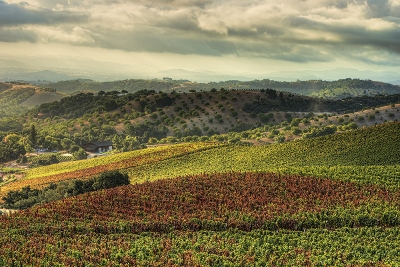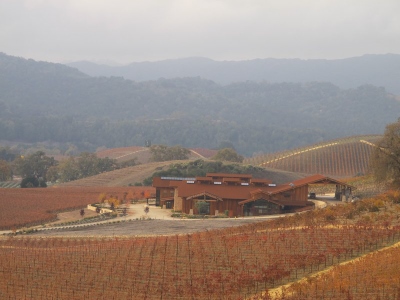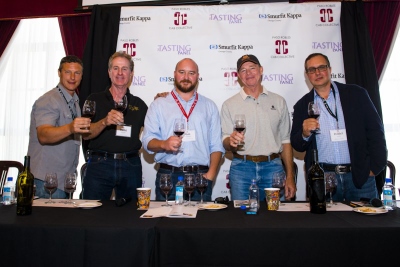How does a Frenchman who has searched the world for the ideal place to grow Cabernet Sauvignon grapes end up in Paso Robles? Data. Daniel Daou measures everything. After moving from France to California with a degree in computer engineering, he built many successful technology companies under a company he and his brother created. In 2007 when he made the decision to buy a vineyard property in Paso Robles and become a winemaker, Daniel had done his research. He found just the right conditions up on a mountain (now nicknamed DAOU Mountain) for growing world class Cabernet.
Daniel aspires to make one of the best Cabernet Sauvignons in Paso Robles and to rival the top wines of the world. When I asked him why he chose Paso Robles, he sat me in front of his computer and showed me charts and spreadsheets filled with numbers underscoring the tremendous potential of the region. He explained we were looking at measurements of chemical compounds called phenolics that contribute to the wine’s color, tannin, aging potential and flavor. The majority of top Cabernet Sauvignons and Bordeaux blends from Bordeaux, Napa and other prestigious wine regions produce phenolics in the 200-250 range (measured as parts per million of anthocyanins). DAOU Mountain exceeds that! Daniel’s wines regularly measure in the range of 280-320.
If, like me, you’re not a numbers person, you can look at Daniel’s other research: the environment. The soil types on DAOU Mountain, and other parts of Paso Robles, are similar to the soils of Bordeaux, the benchmark region for Cabernet, Merlot and the three other “Bordeaux” varietals (Malbec, Petit Verdot and Cabernet Franc). Both have calcareous clay with components of limestone (a rarity in California), which is known for giving wine natural acidity and “minerality,” resulting in more balanced, structured and complex wines. Paso Robles also gets a lot of sunny days and, in parts such as DAOU Mountain, cool air flowing in from the Templeton Gap. All in all, pretty much perfect conditions. Some sites in Paso Robles have the unique ability to make wines that are both age-worthy and delicious young – an enviable combination.
But great wines can’t be made just anywhere in Paso Robles. The region has 614,000 acres of grapes planted in total, which makes it a larger grape growing area than Napa and Sonoma put together. The good news is the government just approved 11 new AVAs (American Viticulture Areas) within the larger Paso Robles AVA to help identify areas with distinct geological and climatic conditions that are best suited for producing particular types of wine. While it might be confusing at first, this should help people better understand Paso Robles and maximize the quality potential for each of the newly named AVAs.

Parrish Family Vineyard flies Peregrine falcons to protect their Cabernet Sauvignon from bird attacks. Cecily Ray Photography.
I have tried to understand why Paso Robles hasn’t yet achieved the same level of prestige as Napa, even though it’s capable of making world class Cabernet Sauvignon. Perhaps it’s because of the broad range of growing conditions and grapes varieties planted (Syrah, Grenache and at least 40 others) that Paso’s greatest wines have previously been overlooked. But recently Cabernet producers are getting the attention they deserve. There is a new group called the Paso Robles CAB Collective, a community of 28 grape growers and winemakers producing Cabernet and other Bordeaux varietals. They are sharing best practices, improving winemaking and grape growing techniques and quickly elevating the status of the region as a whole.
Savvy wine drinkers (that’s you!) will soon realize there are regions in California outside of Napa where they can find high quality wines with equitable pricing. The current prices in Napa (and Bordeaux) make the top wines inaccessible to the average wine drinker, and price doesn’t always match the quality. In addition, the wine tasting experiences are rarely personal. Paso Robles can offer better value and a more enjoyable visit.
Fame is inevitable for Paso Robles, and unfortunately no one is immune from the residual effects of stardom. We will see increases in pricing to go along with the increase in demand. But Daniel, who has some of the higher priced wines in the region, vows to always over deliver for the price. That may be hard to imagine with a new wine he’s releasing next year that will sell for $250 a bottle. But Daniel says it will taste like a $500 bottle. This might not be a distinction the average wine drinker can make, but these are not average wines. He’s only making 50 cases. And I have no doubt he’ll sell out.
Here is my top-five list of Cabernet Sauvignon producers in Paso Robles (the rest aren’t far behind):
On the Paso Robles CAB Collective website, you’ll find more detail on these five plus 23 more great Cabernet and Bordeaux varietal producers to check out.




